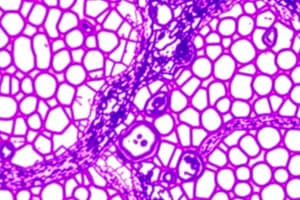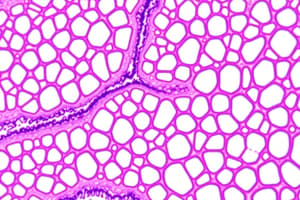Podcast
Questions and Answers
What is a major difference between loose connective tissues and dense connective tissues?
What is a major difference between loose connective tissues and dense connective tissues?
- Loose connective tissues have a higher density of cells.
- Loose connective tissues contain fewer collagen fibers. (correct)
- Dense connective tissues contain more elastic fibers.
- Dense connective tissues have a lower concentration of fibroblasts.
Which cell type is commonly found in fluid connective tissues?
Which cell type is commonly found in fluid connective tissues?
- Fibrocytes
- Chondrocytes
- Osteocytes
- Red blood cells (correct)
What are the three categories of connective tissues?
What are the three categories of connective tissues?
- Fibrous, solid, and elastic
- Loose, dense, and supportive (correct)
- Epithelial, supportive, and muscular
- Liquid, structural, and fibrous
What is the function of chondrocytes in cartilage?
What is the function of chondrocytes in cartilage?
Which type of connective tissue is found in tendons and ligaments?
Which type of connective tissue is found in tendons and ligaments?
Which of the following is an avascular type of connective tissue?
Which of the following is an avascular type of connective tissue?
What pigment primarily determines skin color?
What pigment primarily determines skin color?
What is the primary cell type found in the epidermis?
What is the primary cell type found in the epidermis?
What is the primary focus of histology?
What is the primary focus of histology?
What type of tissue does the ectoderm develop into?
What type of tissue does the ectoderm develop into?
What characteristic of epithelial tissues indicates that they lack blood vessels?
What characteristic of epithelial tissues indicates that they lack blood vessels?
Which type of cell junction allows communication between adjacent cells?
Which type of cell junction allows communication between adjacent cells?
Which type of epithelial cell is primarily involved in absorption and secretion?
Which type of epithelial cell is primarily involved in absorption and secretion?
What is the function of tight junctions in epithelial tissues?
What is the function of tight junctions in epithelial tissues?
Which of the following is true about the epidermis?
Which of the following is true about the epidermis?
What is the primary function of desmosomes in epithelial tissues?
What is the primary function of desmosomes in epithelial tissues?
What is the primary function of dendritic cells in the skin?
What is the primary function of dendritic cells in the skin?
In which of the following locations would you find thick skin?
In which of the following locations would you find thick skin?
Which layer of the epidermis contains more than 27 layers of cells?
Which layer of the epidermis contains more than 27 layers of cells?
What type of connective tissue is the papillary layer of the dermis primarily composed of?
What type of connective tissue is the papillary layer of the dermis primarily composed of?
What is the role of osteoclasts in bone tissue?
What is the role of osteoclasts in bone tissue?
Which component of hair is considered the actual structure that is visible above the skin?
Which component of hair is considered the actual structure that is visible above the skin?
What is the name of the process involved in the formation of bone?
What is the name of the process involved in the formation of bone?
Which cells are known as mature bone cells?
Which cells are known as mature bone cells?
What is the primary process by which long bones form?
What is the primary process by which long bones form?
What is the role of the metaphysis in bone growth?
What is the role of the metaphysis in bone growth?
Which hormone stimulates the production of osteoblasts?
Which hormone stimulates the production of osteoblasts?
What is the effect of parathyroid hormone (PTH) on bone tissue?
What is the effect of parathyroid hormone (PTH) on bone tissue?
What happens when calcitonin is secreted?
What happens when calcitonin is secreted?
Which vitamin is NOT mentioned as necessary for bone growth?
Which vitamin is NOT mentioned as necessary for bone growth?
Which of the following conditions indicates bones are porously weakened?
Which of the following conditions indicates bones are porously weakened?
Which bones in the pelvic girdle belong to the axial skeleton?
Which bones in the pelvic girdle belong to the axial skeleton?
What is the key feature that differentiates a true rib from a false rib?
What is the key feature that differentiates a true rib from a false rib?
Which statement accurately describes the difference between a canal and a fissure?
Which statement accurately describes the difference between a canal and a fissure?
Why do children have more bones than adults?
Why do children have more bones than adults?
What distinguishes a sutural bone from a sesamoid bone?
What distinguishes a sutural bone from a sesamoid bone?
How do the spinous processes of thoracic vertebrae differ from lumbar vertebrae?
How do the spinous processes of thoracic vertebrae differ from lumbar vertebrae?
Flashcards are hidden until you start studying
Study Notes
Tissues and Histology
- Histology is the study of tissues; cytology focuses on cells.
- Cytosol is the liquid inside cells; extracellular fluid is found between cells.
- Embryonic development includes three germ layers: ectoderm (nervous system, epidermis), mesoderm (connective tissues, including bones), and endoderm (internal organs).
- Epithelial tissue is characterized by cellularity (cells closely packed), polarity (apical and basal surfaces), avascularity (lack of blood vessels), innervation (nerve supply), attachment to basement membrane, and fast regeneration.
Cell Junctions in Epithelium
- Gap junctions allow communication between cells.
- Tight junctions create a barrier by sealing cells together.
- Desmosomes anchor cells together with adhesion proteins.
Types and Functions of Epithelial Cells
- Cuboidal cells are primarily involved in absorption and secretion.
- Functions of epithelial cells include protection, diffusion, absorption, and secretion.
Connective Tissues
- Differentiation between loose connective tissue (like areolar, adipose, reticular) and dense connective tissue (dense regular and irregular).
- Fibroblasts are present in connective tissues, but absent in epithelial tissues.
- Three categories: fibrous connective tissue (tendons, ligaments), fluid connective tissue (blood, lymph), and supportive connective tissue (bones, cartilage).
Muscle and Neural Tissue
- Muscle tissue includes skeletal (voluntary), smooth (involuntary), and cardiac (heart).
- Neural tissue is responsible for transmitting signals throughout the body.
Integumentary System
- Comprises skin, hair, nails, and associated glands; largest organ of the body (15% of body mass).
- Keratinocytes are the most common cells in the skin, hair, and nails.
- Skin layers: epidermis (stratified squamous epithelium), dermis (areolar and dense irregular connective tissue), and hypodermis.
- Skin color is determined by various pigments.
Skin Structures and Functions
- Thick skin (5 layers, on palms and soles) vs. thin skin (4 layers, throughout the body).
- Epidermis layers: stratum basale, stratum spinosum, stratum granulosum, stratum lucidum, and stratum corneum.
- Structures include sebaceous glands (oil), sweat glands, hair follicles, and various sensory receptors (Pacinian and Tactile corpuscles).
Hair Growth and Cycle
- Hair grows from the hair follicle, with the hair bulb at the base and the hair shaft visible above.
- Hair cycle phases: anagen (growth), catagen (transition), telogen (resting).
Nail Anatomy
- Nail components include nail body, nail plate, nail root, eponychium, and lunule.
- Mitosis occurs at the nail matrix.
Bone Tissue
- Bone is a supportive connective tissue classified into two formation processes: endochondral ossification (for long bones) and intramembranous ossification (for flat and irregular bones).
- Critical cells: osteogenic (stem cells), osteoblasts (bone builders), osteocytes (mature bone cells), and osteoclasts (bone resorption).
- Hormonal regulation of bone growth: growth hormone, testosterone, thyroxine, parathyroid hormone (PTH), and calcitonin maintain calcium homeostasis.
Skeletal System Concepts
- Pectoral girdle and pelvic girdle bones differ from axial skeleton bones.
- Anatomical terms of skeletal features include sinus, foramen, condyle, process, and others.
- Number of bones differs between children and adults due to fusion.
- Recognize differences in male and female pelvis structures and rib classifications (true vs. false ribs).
Common Conditions
- Osteopenia: decreased bone density; osteoporosis: porous and fragile bones.
- Understand implications of vertebral changes and their effects on back pain.
Studying That Suits You
Use AI to generate personalized quizzes and flashcards to suit your learning preferences.




